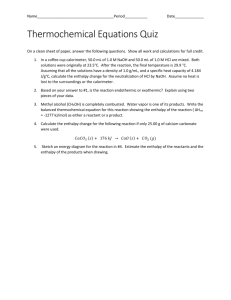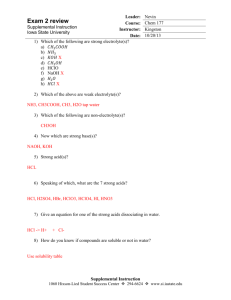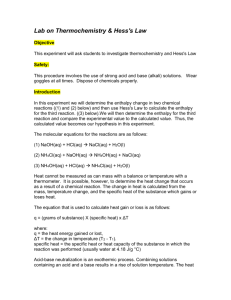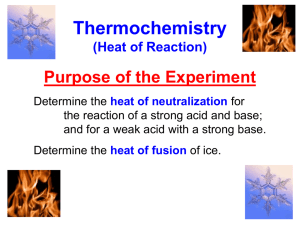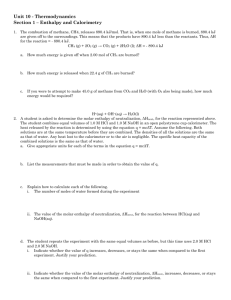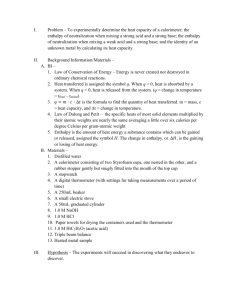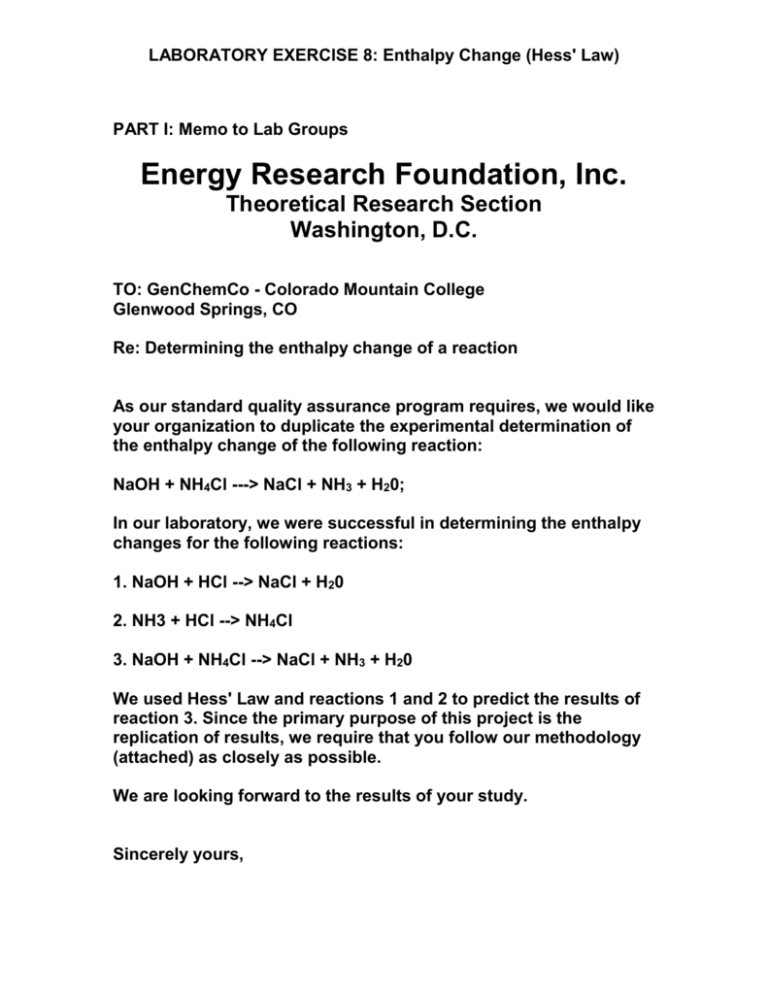
LABORATORY EXERCISE 8: Enthalpy Change (Hess' Law)
PART I: Memo to Lab Groups
Energy Research Foundation, Inc.
Theoretical Research Section
Washington, D.C.
TO: GenChemCo - Colorado Mountain College
Glenwood Springs, CO
Re: Determining the enthalpy change of a reaction
As our standard quality assurance program requires, we would like
your organization to duplicate the experimental determination of
the enthalpy change of the following reaction:
NaOH + NH4Cl ---> NaCl + NH3 + H20;
In our laboratory, we were successful in determining the enthalpy
changes for the following reactions:
1. NaOH + HCl --> NaCl + H20
2. NH3 + HCl --> NH4Cl
3. NaOH + NH4Cl --> NaCl + NH3 + H20
We used Hess' Law and reactions 1 and 2 to predict the results of
reaction 3. Since the primary purpose of this project is the
replication of results, we require that you follow our methodology
(attached) as closely as possible.
We are looking forward to the results of your study.
Sincerely yours,
D.H. Calorimas
Vice President of Research
PART II: InterLab Memo
GenChemCo Industries
COLORADO MOUNTAIN COLLEGE
InterLab Memo:
Re: Determining the enthalpy change of chemical reactions
As you can see from the attached letter, our group was asked to
determine enthalpy changes for several chemical reactions. Since
we are supposed to replicate a series of previously performed
reactions, the instructions you are supposed to follow are
included.
As usually, the class as a whole should brain-storm what we are
supposed to do, whether the instructions are clear, and some of
the details of the techniques involved. I recommend that each
group perform one reaction, calculate the enthalpy change of the
reaction, and share information with the other groups. Ultimately,
each group will have to check how closely the three reactions
approximate Hess' Law.
Each work-group will submit a report to me (due two weeks from
today) which should include the following sections:
1. Initial Working Hypothesis.
2. Initial Working Plan.
3. Your data.
---Please show ALL measurements and calculations of your
groups share of the project.
4. Analysis of your data and of the results of the other groups.
---Does the data support your hypothesis? Why? Why not?
5. Further Steps Taken.
---Did you do anything beyond your initial working plan? Why?
What did you find?
6. A Letter of Response.
---Each group should submit a response directed to the client
outlining what you did, what you found, and how this addresses
the questions proposed by the client.
Part III: PROCEDURE FOR DETERMINING ENTHALPY CHANGES
1. Obtain exactly 50 mL of 2.0 M HCl in a clean, dry graduated
cylinder
2. Obtain exactly 50 mL of 2.0 M NaOH or NH3 solution in another
clean, dry graduated cylinder.
3. Measure the temperature of each of the solution, using the same
thermometer. Rinse and dry the thermometer after each
measurement. If the temperatures of the various solutions are not
within +/- 0.2 oC, warm or cool the solution until the temperatures
are nearly equal. Record the mean temperature (initial
temperature).
4. Add the acid to the calorimeter. In order to account for
incomplete draining, record the volume of the solution that
remains in the graduated cylinder.
5. Add the base to the calorimeter. Again, read the volume left in
the graduated cylinder.
6. Immediately place the top on the calorimeter and begin stirring.
7. Record the temperature to the nearest 0.1 C after 30 seconds
and every 30 seconds thereafter for 4 minutes.
8. Plot the temperature against time, using a spreadsheet or graph
paper. Extrapolate your results to the time of mixing (time = 0
seconds). Record this extrapolated temperature.
9. Calculate q(system) using 4.184 J/(g.oC) and 1.0 g/mL for the
specific heat and density of the solution, respectively, and 10 J/ C
for the specific heat capacity of the calorimeter.
10. Calculate the enthalpy change, delta H, from q(system) and the
number of moles of the acid and base. If you used unequal
volumes of the acid and base solutions, use the number of moles
of the limiting reactant.
11. Repeat steps 1 through 10 for the NH4Cl - NaOH acid-base pair.
Theoretical considerations:
The heat released by the reaction is absorbed by the calorimeter
and its contents. The quantity of heat absorbed by the calorimeter
is Ccal x deltaT. This represents the same magnitude of heat
absorbed by the reaction, but has opposite sign, i.e.
qrxn = - Ccal x deltaT
q(system) = - (Csoln x deltaT x masssoln) - (Ccal x deltaT)
mol NaOH or NH3 or HCl = vol (L) x 2.0 mol/L
deltaH = q(system) divided by moles of reactant
All contents copyrighted (c) 1998
Peter Jeschofnig, Ph.D., Professor of Science, Colorado Mountain College
All Rights reserved

